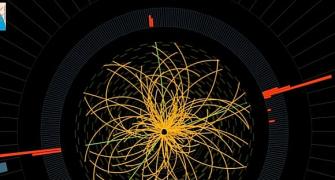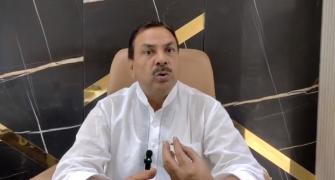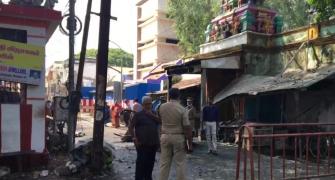 "I hate to call it the God particle," says Bihar-born Professor Vivek Sharma, one of the first people to know about the existence of the Higgs Boson, which scientists say is key to understanding the universe in an interview to George Joseph
"I hate to call it the God particle," says Bihar-born Professor Vivek Sharma, one of the first people to know about the existence of the Higgs Boson, which scientists say is key to understanding the universe in an interview to George Joseph"You and I exist because of this particle, though I hate to call it the God particle," said Professor Vivek Sharma, one of the first people to know about the existence of the Higgs Boson, which scientists say is key to understanding the universe.
Sharma, professor of physics at the University of California, San Diego, heads the Switzerland-and-France-based European Organisation for Nuclear Research's Compact Muon Solenoid experiment -- one of the two large particle physics detectors built on the Large Hadron Collider -- team that found the Higgs Boson.
Two major experiments, one headed by Sharma, confirmed the existence of the sub-atomic particle. The discovery is being hailed as one of the most path breaking in modern times. The new particle is 125 times the mass of a proton. Without this new particle, matter would not exist.
When he was a child, Sharma's mother, a Sanskrit scholar, had told him that the 'Song of Creation' in the Rig Veda says the world was void and formless in the beginning and it was utter chaos. The words moved the young boy.
"The song was a record of what the sages saw and thought thousands of years ago," Sharma had told rediff.com from Geneva in an interview a while ago.
"They were thinking of the origin of the world and from where the mass came to the world. It moved me and has driven me to pursue answers for the ancient question. By the technology of today I am now answering the curiosity posed by my ancestors thousands of years ago."
Two teams, the CMS and Atlas, with about 3,000 scientists, were looking for the Higgs Boson, the subatomic particle considered to be the cause for creating mass. Both teams had almost reached at the same conclusion a few months ago. An official announcement was delayed for further studies.
The teams have built the most complicated machines ever, like the Large Hadron Collider, the particle accelerator where proton-photon collisions are used to search for the Higgs Boson. The multination project cost about $10 billion (Rs 55,000 crore).
"Discovery of the Higgs Boson is a very important and a necessary clue to our understanding of the subatomic world and indeed why the universe exists," Sharma told rediff.com last week.
The particle is named after University of Edinburgh physicist Dr Peter Higgs, who was one of six physicists in the 1960s who suggested that a kind of cosmic molass pervading space is what gives particles their heft. Higgs pointed out that these cosmic molasses would have their own quantum particle, so the branding rights went to him. The particle is also partly named after legendary Indian scientist Satyendra Nath Bose, who worked with Albert Einstein in the 1920s and made discoveries that led to the most coveted prize in particle physics.
A large number of Indian scientists, representing the Saha Institute of Nuclear Physics in Kolkata, the Tata Institute of Fundamental Research in Mumbai, the Harishchandra Research Institute in Allahabad and the Institute of Physics in Bhubaneswar were also involved in the world's most ambitious experiment over the years.
"India is like a historic father of the project," Paolo Giubellino, spokesperson of the Geneva-based CERN, told the Press Trust of India.
How will the discovery impact life and science?
"Discoveries are made out of the curiosity," Sharma told rediff.com. "We do not know how the discoveries will affect our life or knowledge. But the advanced technologies we have developed will percolate soon into public use. An example is the World Wide Web, which was created at CERN for physicists to exchange data seamlessly... We gave this away to the world without cost, and it has led to a complete transformation of how we now communicate apart from the trillions of dollars of transactions currently happening on the web."
As soon as the Higgs Boson discovery was announced, Sharma's eight-year-old daughter, a Std II student in San Diego, e-mailed him a congratulatory message. Sharma's wife works for Motorola.
Rolf-Dieter Heuer, director general, CERN, and others said that it was too soon to know for sure if the particle they found is an impostor as yet unknown to physics, perhaps the first of many particles yet to be discovered. That possibility is particularly exciting to physicists, as it could point the way to new, deeper ideas, the Times noted. Some physicists are still calling it a 'Higgs-like' particle.
Sharma said that the particle "looks very much like a Higgs Boson."
CMS experiment spokesperson Joe Incandela, a physicist at the University of California, Santa Barbara, said, "The results are preliminary but the five-sigma signal we're seeing is dramatic. This is indeed a new particle. We know it must be a Boson and it's the heaviest Boson ever found. The implications are very significant and it is precisely for this reason that we must be extremely diligent in all of our studies and cross-checks."
In Geneva, 1,000 people stood in line all night to get into an auditorium at CERN to hear the announcement July 4. Higgs entered the meeting to sustained ovation.
The next step will be to determine the precise nature of the particle and its significance for our understanding of the universe. Are its properties as expected for the long-sought Higgs Boson, the final missing ingredient? Or is it something more exotic?
All the matter that we can see, however, appears to be no more than about four per cent of the total. A more exotic version of the Higgs particle could be a bridge to understanding the 96 per cent of the universe that remains obscure, according to CERN.
Sharma said the "plan is to continue searching for new subatomic phenomena for the next decade and more."
Born in Muzaffarpur, Bihar, Sharma obtained his master's in physics from the Indian Institute of Technology, Kanpur. He came to the United States in 1984 for higher studies. He also spent five years at CERN in the early 1990s, where he discovered two new subatomic particles. He is a fellow of the American Physical Society and received the UCSD Academic Senate award for distinguished teaching. Other awards he has won include the Cottrell Scholar Award, Research Corporation, (1998 ); Faculty for the 21st Century, Project Kaleidoscope (1998); and National Talent Prize, Ministry of Science & Education (India), 1979.
Asked if the new findings will change man's belief in religion/God, Sharma, who planned to return to the US in a few days, said, "God is some thing very private and a matter of each individual's belief. I do experimental physics, not God."
Photo: Professor Vivek Sharma








